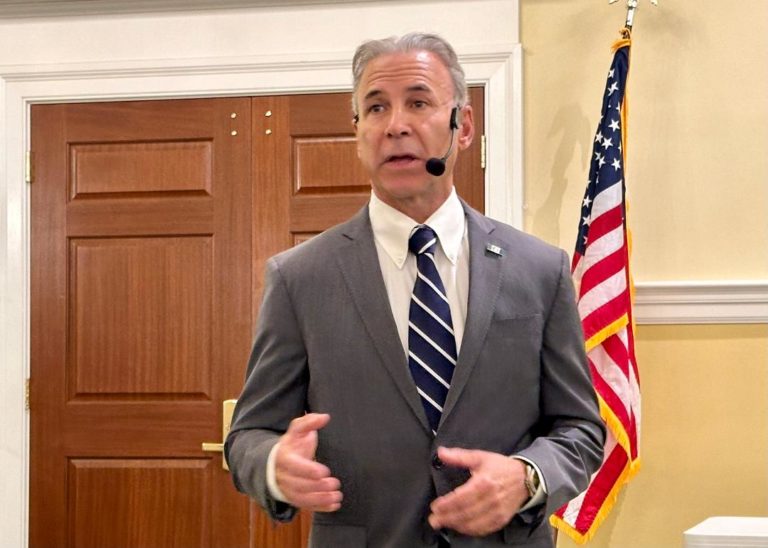

By Anne W. Semmes
Sentinel Correspondent
Bird lovers of Greenwich and statewide will be heartened by the news from Audubon Connecticut of five new Important Bird Areas or IBA’s established across the state thanks to a partnership of Audubon with the Connecticut Department of Energy and Environmental Protection (DEEP).
The new areas are forest landscapes in the main with the exception of the “Mouth of the Connecticut River” that includes Old Lyme and its Great Island historic population of ospreys, now the Roger Tory Peterson Wildlife Management Area; and Old Saybrook with the Ragged Rock Creek Wildlife Management Area.
“We have long recognized the value of IBAs as a tool for conservation of imperiled bird species across Connecticut,” said DEEP Commissioner Robert Klee at the news sharing event last week at the Audubon Miles Sanctuary in Sharon. “Establishing these five sites with Audubon Connecticut,” he said, “and building public recognition of their value will help us preserve the habitats these sites provide and the bird species that depend on them.”
The Audubon Miles Sanctuary included with the Housatonic State Forest Block marks one of the five IBA’s. The other three are the Macedonia Forest Block in the northwest corner of the state, the mid-state Meshomasic Forest Block, and the Lyme Forest Block.
“We’re grateful for DEEP’s support and that of our other partners,” offered Stewart J. Hudson, the Greenwich-based executive director of Audubon Connecticut. “Together we can protect these special habitats for birds, and people, for generations to come.”

Connecticut)
“Connecticut ranks sixth in the nation in terms of the number of individuals who care about and enjoy watching birds,” said Hudson, “so it’s important to note that IBA status helps enhance habitat protection for species of global concern, such as the Cerulean Warbler, Saltmarsh Sparrow, and Wood Thrush.”
Stewart pointed to the long time efforts of Patrick Comins, the Stratford-based director of Bird Conservation for Audubon Connecticut, for identifying the sites and working with DEEP and other conservation NGO’s and private landowners for the establishment of the new IBA’s.
“These five new IBA’s are particularly exciting,” said Comins, who spoke of the challenge of securing them. “I nominated the Meshomasic Forest Block site back in the 1990’s,” he said. “It’s been 15 years of work – since I first started work with Audubon in 2000.”
Comins told of particular bird species of concern to benefit from the protected IBA’s: “the Wood Thrush in the Meshomasic Forest Block, the Scarlet Tanager in the Macedonia/Audubon Sharon block, the Veery in the Miles and Housatonic blocks, the Saltmarsh Sparrow at the Mouth of the Connecticut River, and the Cerulean Warbler in the Lyme Forest Block.”
Comins commended the state for its stewardship of these forest blocks. “Their management has helped grow the forest and diversify habitats. An unmanaged forest can trend towards a dense, even aged stand, often with little understory and few canopy breaks. But when there’s a gap, even a small one, and light hits the floor of the forest, plant and insect diversity increases. This benefits forest birds that hunt these gaps including Scarlet Tanagers and Eastern Wood-Pewees.”
Comins described how Audubon Connecticut works in partnership with the state and other groups “to maintain public access to some sensitive areas with a consideration of the nesting and migratory birds that these sites are so vital to.” “Proper stewardship is important for access and for the birds,” he said, as “Parks are for people and for wildlife.”
Comins praised the Town of Greenwich for being “an exceptional steward” of its three IBA’s, that include Audubon Greenwich, Greenwich Point and Great Captain’s Island. “We’ve worked closely with the town on a management plan,” he said.
“On Great Captain’s Island he said, “The Great Egrets are holding their own, and so are the Black Crowned Night Herons.” One species not doing as well he said is the Snowy Egret. “It’s going down regionally which may have to do with lost forage opportunities.”
Comins called the other end of Great Captain’s Island that hosts a protected nesting area for the American oystercatcher “a really cool area.” “You have to be careful if you go there because you can step on the eggs,” but he instructed, “People will be better stewards if they understand this, for there are less predators like crows and foxes when there are people.”
Hudson noted that it was Greenwich’s three IBA sites that were part of Audubon’s original set of IBAs announced in 2000. “They are a great illustration of how local conservation can make a difference on a flyway or even global scale. These five newly announced IBAs as added to an impressive inventory of sites previously recognized in Connecticut, now bring the total number in the state to 38.”
.




